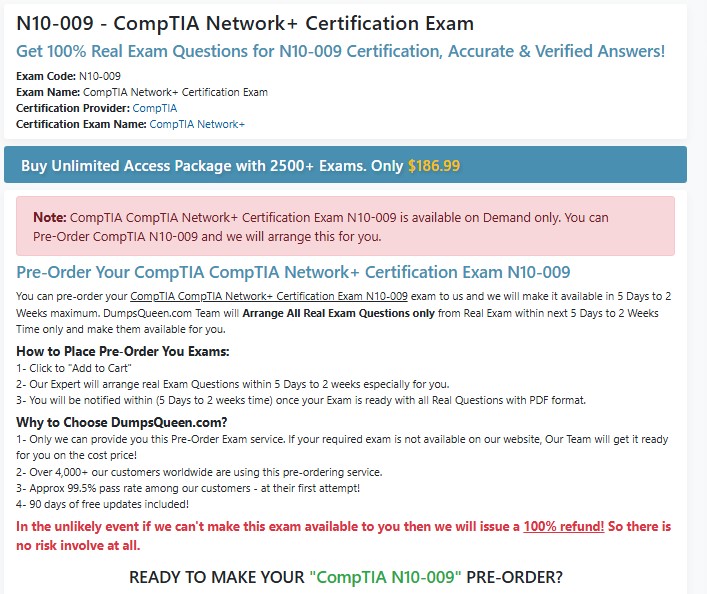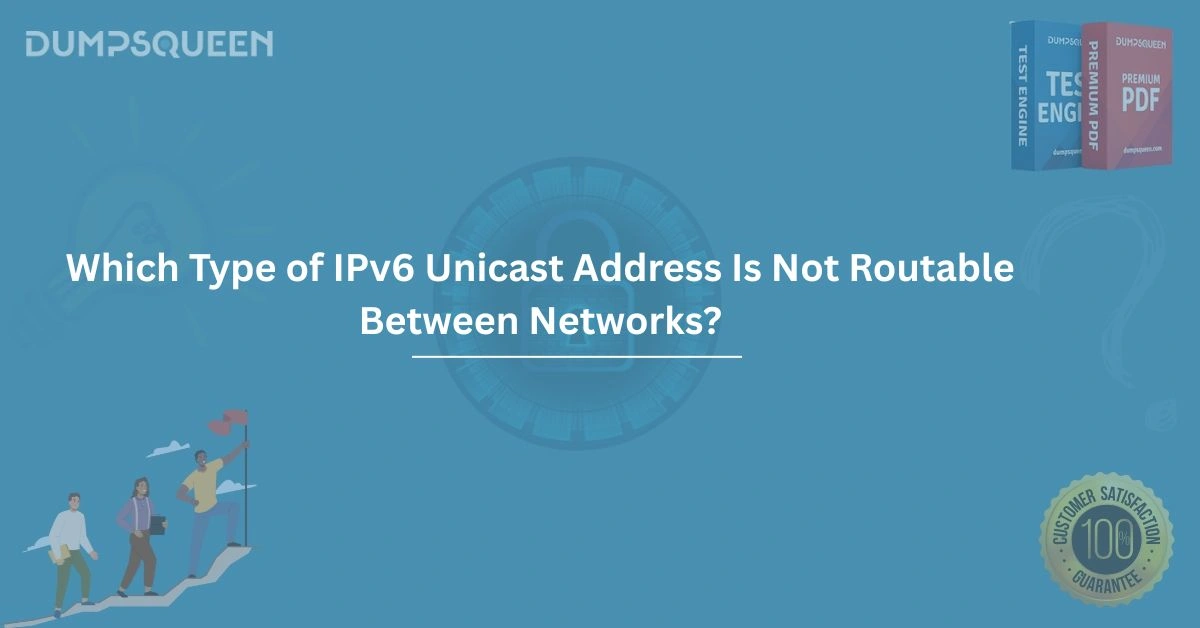Introduction
The transition from IPv4 to IPv6 has been a significant milestone in the evolution of networking, addressing the critical issue of IP address exhaustion while introducing enhanced features for modern networks. IPv6, with its vast address space of 128 bits, offers a multitude of address types to suit various networking needs. Among these, unicast addresses play a pivotal role in enabling one-to-one communication. However, not all IPv6 unicast addresses are routable between networks, a characteristic that can be confusing for network professionals and students alike. Understanding which type of IPv6 unicast address is not routable between networks is essential for designing secure and efficient network architectures.
This comprehensive guide, brought to you by DumpsQueen, delves into the intricacies of IPv6 unicast addresses, focusing specifically on identifying and understanding non-routable unicast addresses. Whether you’re preparing for a certification exam or seeking to enhance your networking knowledge, DumpsQueen is your trusted partner in mastering complex networking concepts. Let’s explore the world of IPv6 unicast addresses, their types, and why certain addresses are confined to local networks.
The Basics of IPv6 Unicast Addresses
IPv6 unicast addresses are designed for one-to-one communication, where a single source sends data to a single destination. Unlike IPv4, which has a limited address space, IPv6 provides a staggering 340 undecillion addresses, enabling unique identification for every device on the planet. Unicast addresses are categorized based on their scope and purpose, including global unicast, link-local, unique local, and others. Each type serves a specific function in network communication, and understanding their differences is crucial for network configuration and management.
At DumpsQueen, we emphasize the importance of grasping foundational concepts before diving into advanced topics. IPv6 unicast addresses are structured with a prefix, interface identifier, and other components that define their scope and routability. While global unicast addresses are routable across the internet, other types, such as link-local addresses, have restricted scopes that limit their reach. This distinction is key to answering the question of which IPv6 unicast address is not routable between networks.
Types of IPv6 Unicast Addresses
To identify non-routable IPv6 unicast addresses, we must first examine the different types of unicast addresses defined in the IPv6 protocol. Each type has a unique prefix and scope, determining its usability in local or global contexts.
Global Unicast Addresses
Global unicast addresses are the IPv6 equivalent of public IPv4 addresses. They are routable across the internet and assigned by regional internet registries (RIRs) to organizations. These addresses typically begin with the prefix 2000::/3, covering the range from 2000:: to 3FFF::. Global unicast addresses are designed for devices that need to communicate across different networks, such as web servers or cloud services. Their global scope ensures that packets can traverse multiple routers and networks to reach their destination.
At DumpsQueen, we provide resources to help you understand how global unicast addresses are allocated and configured. For example, a global unicast address like 2001:0db8:1234::1 can be used to access a device from anywhere in the world, provided proper routing is in place. These addresses are inherently routable, making them unsuitable as the answer to our question.
Link-Local Addresses
Link-local addresses are a unique type of IPv6 unicast address with a prefix of FE80::/10, meaning the first ten bits are 1111111010. These addresses are automatically configured on every IPv6-enabled interface and are valid only within the local network segment or link. Link-local addresses are used for communication between devices on the same physical or virtual link, such as during neighbor discovery or address autoconfiguration.
The defining characteristic of link-local addresses is their non-routability. Routers do not forward packets with link-local source or destination addresses beyond the local link. This restriction is intentional, as link-local addresses are meant for tasks like auto-configuration, neighbor discovery, and communication within a single network segment. For instance, a device with the link-local address FE80::1%eth0 cannot use this address to communicate with a device on a different subnet, as the address is confined to its link.
DumpsQueen study materials highlight the practical implications of link-local addresses. For example, when configuring a router, you may encounter link-local addresses in routing protocols like OSPFv3, where they facilitate neighbor adjacency formation. Understanding their non-routable nature is critical for troubleshooting and network design.
Unique Local Addresses
Unique local addresses (ULAs) are another type of IPv6 unicast address, identified by the prefix FC00::/7. However, only addresses with the prefix FD00::/8 are currently used, as the eighth bit must be set to 1. ULAs are designed for private, internal networks and are not routable on the public internet. They provide a way to assign unique addresses within an organization without relying on globally assigned addresses.
While ULAs are not routable between networks in the context of the public internet, they can be routed within an organization’s private network if routing policies allow. This makes their routability context-dependent. For example, an address like FD12:3456:789a::1 can be used for communication between devices in different subnets within the same organization, provided internal routers are configured to forward these packets.
DumpsQueen certification prep resources clarify the nuances of ULAs, helping you distinguish between their internal routability and their non-routability on the global internet. This distinction is vital when comparing ULAs to other unicast address types.
Other Unicast Addresses
IPv6 also defines specialized unicast addresses, such as the loopback address (::1/128) and the unspecified address (::/128). The loopback address is used for testing and communication within a single device, while the unspecified address indicates the absence of an assigned address. Neither of these addresses is routable, but they are not typically considered in discussions of network-to-network routability due to their specific purposes.
At DumpsQueen, we ensure that our learners understand the full spectrum of IPv6 unicast addresses, including these edge cases. However, for the question at hand, link-local addresses stand out as the primary type that is explicitly non-routable between networks.
Why Link-Local Addresses Are Not Routable Between Networks
Link-local addresses are inherently non-routable due to their design and scope. The IPv6 protocol mandates that link-local addresses are valid only on the link where they are configured. This restriction is enforced by several mechanisms:
-
Interface Specification: Link-local addresses require an interface identifier (e.g., %eth0) when used, as they are ambiguous without specifying the link. This requirement prevents routers from forwarding packets with link-local addresses, as the interface context is lost beyond the local link.
-
Router Behavior: IPv6 routers are programmed to drop packets with link-local source or destination addresses when attempting to forward them to another network. This ensures that link-local communication remains confined to the local segment.
-
Protocol Design: Link-local addresses are used for protocols like Neighbor Discovery Protocol (NDP), which operates within a single link. For example, NDP uses link-local addresses to resolve MAC addresses and discover neighbors, tasks that do not require inter-network communication.
DumpsQueen training resources emphasize the practical implications of this non-routability. For instance, if a device attempts to ping another device on a different subnet using a link-local address, the ping will fail because the address cannot be routed. This understanding is crucial for network administrators configuring IPv6 networks.
Comparing Link-Local and Other Unicast Addresses
To solidify our understanding, let’s compare link-local addresses with other unicast address types. Global unicast addresses are routable across networks, making them suitable for internet-wide communication. Unique local addresses, while not routable on the public internet, can be routed within private networks, depending on the organization’s routing policies. In contrast, link-local addresses are strictly confined to their local link, with no possibility of inter-network routing.
This comparison highlights why link-local addresses are the answer to the question of which IPv6 unicast address is not routable between networks. Their restricted scope ensures that they serve local communication needs without impacting external networks, enhancing security and efficiency.
DumpsQueen practice exams and study guides provide scenarios to test your understanding of these differences. For example, you might encounter a question asking you to identify the address type used in a specific protocol or configuration, reinforcing the importance of link-local addresses in IPv6.
Practical Implications for Network Professionals
For network professionals, understanding non-routable IPv6 unicast addresses is more than an academic exercise—it has real-world implications. Link-local addresses are critical for tasks like:
-
Auto-Configuration: Devices use link-local addresses during stateless address autoconfiguration (SLAAC) to obtain global unicast addresses.
-
Neighbor Discovery: Protocols like NDP rely on link-local addresses to maintain neighbor relationships and detect network changes.
-
Routing Protocols: Some routing protocols, such as OSPFv3, use link-local addresses for neighbor adjacency, simplifying configuration.
However, the non-routable nature of link-local addresses means they cannot be used for communication between subnets or across the internet. Network administrators must configure global or unique local addresses for such purposes, ensuring proper routing and connectivity.
DumpsQueen certification-focused resources, available on our official website, provide practical examples and case studies to help you apply this knowledge. Whether you’re studying for Cisco, CompTIA, or other networking certifications, our materials are designed to bridge the gap between theory and practice.
Conclusion
Understanding which type of IPv6 unicast address is not routable between networks is a fundamental concept for anyone working with IPv6. Link-local addresses, with their FE80::/10 prefix, are explicitly designed to operate within a single network link, making them non-routable by routers. This characteristic distinguishes them from global unicast and unique local addresses, which serve different purposes in network communication.
At DumpsQueen, we are committed to empowering network professionals and students with the knowledge and resources needed to succeed. Our comprehensive study materials, practice exams, and expert guidance, available on our official website, make complex topics like IPv6 accessible and actionable. Whether you’re preparing for a certification or seeking to deepen your networking expertise, DumpsQueen is your trusted partner.
By mastering the nuances of IPv6 unicast addresses, you can design more secure, efficient, and scalable networks. Visit DumpsQueen today to explore our resources and take the next step in your networking journey.
Free Sample Questions
Question 1: Which type of IPv6 unicast address is not routable between networks?
A) Global Unicast
B) Link-Local
C) Unique Local
D) Loopback
Answer: B) Link-Local
Question 2: What is the primary reason link-local addresses are not routable?
A) They lack a valid prefix
B) Routers drop packets with link-local addresses
C) They are reserved for multicast communication
D) They are globally unique
Answer: B) Routers drop packets with link-local addresses
Question 3: Which protocol commonly uses link-local addresses for communication?
A) BGP
B) Neighbor Discovery Protocol (NDP)
C) RIP
D) MPLS
Answer: B) Neighbor Discovery Protocol (NDP)
Question 4: A device with the address FE80::1%eth0 attempts to communicate with a device on a different subnet. What will happen?
A) The communication will succeed
B) The packet will be dropped by the router
C) The address will be converted to a global unicast address
D) The device will request a new address
Answer: B) The packet will be dropped by the router



